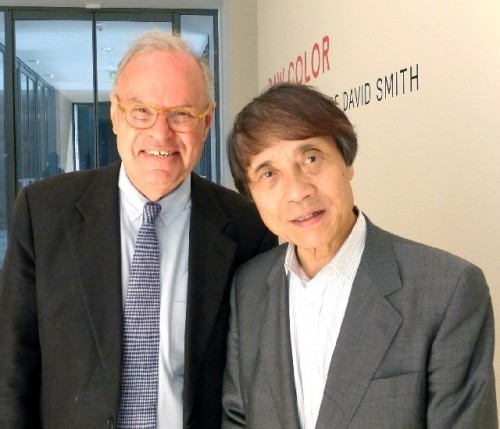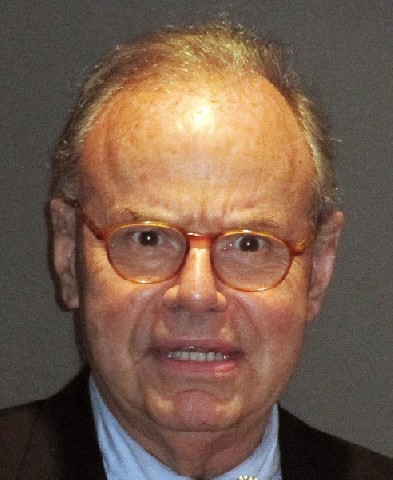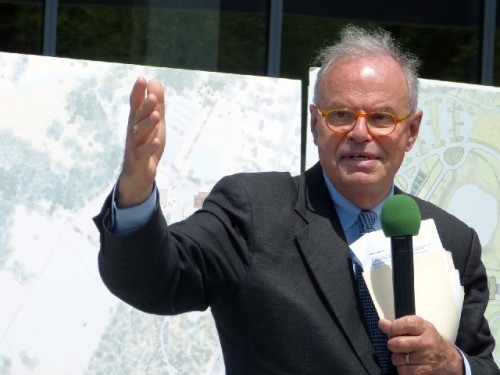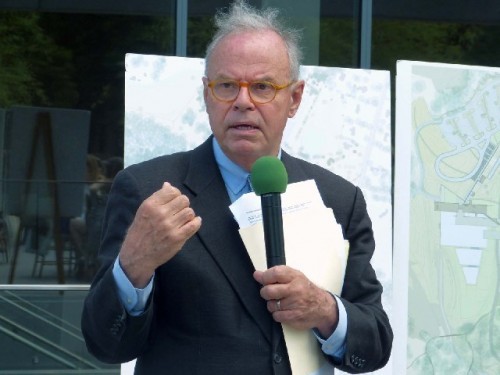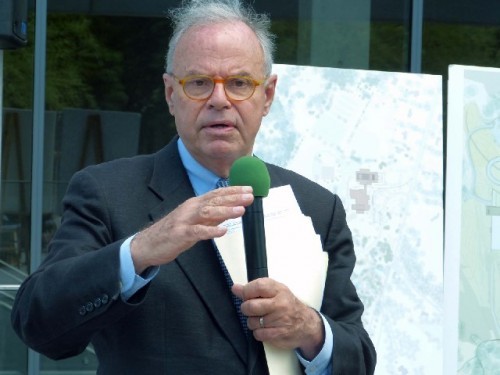Michael Conforti Director of Clark Art Insitiute
Retires As of August 31, 2015
By: Charles Giuliano - Mar 19, 2015
After some 20 productive years as director of the Clark Art Institute in Williamstown, Mass., now 69. Michael Conforti will resign effective August 31, 2015.
More than a museum the Clark with Williams College has an MA program for those entering the museum field. It houses one of the première art libraries and research centers in North America. This is a magnet for scholars and Clark fellows.
The core of the collection of founders Frances and Stirling Clark is focused on 19th century French painting with particular strength in works by Pierre Auguste Renoir. The museum owns a signature work by J. M. W. Turner this was greatly enhanced by the 2007 gift of more than 300 works that established the Manton Collection of British Art with an accompanying $50 million in funding for the Institute. The collection is notable for masterpieces by the American artists Winslow Homer, Frederick Remington and John Singer Sargent.
When the Clark was closed for extensive renovation works from the French paintings collection toured twelve cities in Europe, Asia and North America reaching a combined audience of 2.4 million viewers.
Last summer the Clark unveiled renovations and construction completing a master plan by Tadao Ando with interior design and installations by Selldorf Architects and landscape architecture by Reed Hilderbrand.
During one of many encounters over the years I asked Conforti when he might move on to a position at a major museum. While widely respected at the time the Clark had limited space for special exhibitions and an all purpose lobby/ book store/ cafe. The Institute drew an annual attendance of some 150,000 for its permanent collection. For the most part it was not a player in mounting blockbuster special exhibitions.
As was often the case Conforti was surprised, coy and a bit feisty when he responded. In essence he stated why on earth would I leave the best job in the world?
While accompanying the Clark's masterpieces and raising some $145 million for expansion/ renovation Conforti was a world traveler. Now and then he would touch down to host special events in Williamstown. That sounds like fun but now approaching his 70's it's more attractive to sleep in your own bed now and then.
Because he was out of the office so frequently press and social events were opportunities for spontaneous dialogues. One sensed that Conforti enjoyed sparring with the media. We asked him about programming more modern and contemporary art. Considering the chits that he had accumulated through that great tour of the Clark's treasures he was dodgy when I asked about a date for a potential Treasures from the Prado exhibition. It's likely to happen in some form but now apparently not on his watch.
We have also kept on both Conforti and Joe Thompson regarding a build out and programming for a prominent building on the MoCA campus. The standard answer has been wait and see once the Ando project was finished. It remains to be seen if something will develop between now and August. We asked Conforti about the role of contemporary art at the Clark. Or will that be an agenda for the new director.
There has been speculation about friction between Conforti and Ando about design and cost decisions. Ando is known for concrete surfaces which Conforti insisted on veneering with stone. It is thought that the bottom line has exceeded the original budget. This is not surprising with ambitious and complex construction and renovation projects. The former lobby and auditorium are yet to be completed as a study center. There was no programming in that space this season including cancelled concerts, events and the popular Live in HD series of broadcasts from the Metropolitan Opera.
The Clark reports that on Conforti's watch the endowment grew from $128 million to $357 million. Like all institutions there were setback and austerity measures during the market crash of 2008. It would take astute financial analysis to evaluate the performance of the endowment over the past 20 years. How would one factor in the capital campaign for $145 million. Was more than that actually spent and if so where did the funds come from?
It has been Conforti's style to keep a tight lid on information about the inner workings of the Clark. While national media are provided with greater access they are not notable for asking tough questions. Most of the visitors are critics who are not trained or inclined to pursue institutional journalism. Typically, the Clark made much of accolades from Apollo Magazine. But how elitist can you get? The magazine is read by a handful of scholars and has little or no influence on those who visit the museum.
Like Malcolm Rogers, now retiring from the Museum of Fine Arts, it is likely that Conforti will best be remembered as a bricks and mortar director. They have labored mightily and with astonishing success to grow their institutions. For both it has been the culmination of brilliant and successful careers.
The pioneers of modern museums were Perry T. Rathbone of the MFA and Thomas Hoving at the Met. When he retired from the Met several years ago Conforti hosted a dialogue with Philippe de Montebello.
In another major staff change chief curator, Richard Rand, is taking a position at the Getty.
It will be up to younger directors to decide and program expanded facilities and all those new toys.
They and other museum directors of their generation represented a paradigm shift away from scholarly, socially connected, caretakers and custodians to builders, developers and entrepreneurs.
It will be interesting to see how museums which have enjoyed such expansion and growth will approach moving forward through the next generation.
Unless one considers opportunities in contemporary art the era of forming great collections is now seemingly over. One may get lucky with a Manton acquisition for the Clark or the Lane Collection for the MFA some time ago. In today's inflated market, however, that entire $357 million endowment, arguably, might represent no more than a dozen first class acquisitions.
More and more museums have strategized how to move their masterpieces around like pieces on a chess board. Visiting museums today often means discovering that the greatest treasures are on the road generating cash for ever greater operating expenses. Because the Clark was largely closed during renovations there was little dissent about the masterpieces being on tour. One may say that it is the time honored quid pro quo. You have to lend in order to borrow. But there are ever more examples of tours of non collecting institutions and straight up cash deals.
By September, and a new administration at the Clark, we may start to get straight answers to tough institutional questions.
Of course we will miss and appreciate Conforti who leaves the Clark in better shape than he found it. The museum will appoint an interim director while it undertakes a global search for new leadership.
What follows is the Clark's Press Release
Michael Conforti, the Felda and Dena Hardymon Director of the Clark Art Institute, has informed the Clark’s Board of Trustees that he will retire on August 31, 2015 after more than twenty years in the position. Conforti, who has served as director since November 1994, has been widely credited for his transformational leadership of the Institute and is recognized as a leading innovator and advocate in the museum community. Under Conforti’s direction, the Clark has grown in both size and stature and has established an international reputation as a leader in the generation of new ideas and critical thinking in the field.
“It has been an extraordinary privilege for me to have the opportunity to be a part of the Clark’s growth over these last twenty years,” Conforti said. “There have been many wonderful opportunities that have propelled the Clark in new directions and have set the course for an even brighter future. The Board of Trustees and our remarkable staff have fueled the Clark’s success on many fronts and I have been proud to be a part of this important and exciting undertaking. This is the right moment to encourage a new generation of leaders to begin to imagine the plans and programs that will continue to advance the Clark and its unique dual mission.”
During his tenure Conforti advanced the Institute’s dual mission as both an art museum and a center for research and higher education in the visual arts. Under Conforti’s leadership, the Clark’s special exhibition programs have won acclaim for their rigorous scholarship and promotion of new thinking on a diverse range of subjects. The Institute also initiated a number of international programs, including a recent tour of its French paintings collection, which drew more than 2.4 million visitors in twelve cities across Europe, Asia, and North America, as well as exhibitions and cultural exchange programs in partnership with Chinese museums. Conforti gave form to the Clark’s Research and Academic Program (RAP) which has become a leading academic forum for the field. The program has welcomed more than 300 scholars from twenty-seven nations who have pursued fellowships at the Institute, and has played a central role in linking art historians and scholars through engagements in Africa, Asia, and Europe. The Institute’s endowment has grown from $128 million to $357 million, and its art and library collections have expanded considerably through important gifts and acquisitions. These include the 2007 gift of more than 300 works that established the Manton Collection of British Art with an accompanying $50 million in funding for the Institute—making it the largest gift to an American museum in that year.
These programs have spurred the growth of tourism and positioned the Institute as a leader in the regional economy. Conforti’s early support for the Massachusetts Museum of Contemporary Art (MASS MoCA) forged an ongoing partnership that is central to the area’s growing national prominence as a rich and diverse cultural destination, and he has played a leadership role in civic and regional economic development organizations. In addition, the Clark’s public outreach efforts have expanded to serve its diverse constituencies. Thousands of children visit the Institute annually to participate in its award-winning arts education programs, and the Clark has developed a series of specialized programs to engage underserved communities, as well as free family programs that attract thousands of visitors annually.
Most recently, Conforti led the Clark’s $145 million capital campaign to fund its campus expansion, which opened in July 2014 to public and critical acclaim, including Apollo magazine’s award for 2014 Museum Opening of the Year. An international team of architects and engineers, including Tadao Ando, Selldorf Architects, Reed Hilderbrand, and Gensler, reconceived the 140-acre campus, added two new buildings (the Clark Center and the Lunder Center at Stone Hill), renovated the original Museum Building, and initiated the renovation of the Manton Research Center (scheduled for completion later this year).
“Driven by his creativity, determination, and energy, Michael has overseen a period of exceptional progress at the Clark,” said Andreas Halvorsen and Robert Scott, chair and vice chair, respectively, of the Clark’s Board of Trustees. “His commitment to the Clark’s role in advancing and extending the public understanding of art has been inspirational. We are deeply grateful to Michael for his vision and extraordinary work.”
ABOUT MICHAEL CONFORTI
In addition to his work at the Clark, Michael Conforti has earned international recognition in the museum field as a visionary leader. He served as president of the Association of Art Museum Directors from 2008–2010, and as a trustee (2001–04, 2007–12). Conforti serves on the trustee executive committees of the American Academy in Rome and the Amon Carter Museum (Ft. Worth, Texas), and is a trustee of the Canadian Centre for Architecture (Montreal) and of MASS MoCA. He is also a member of the Hermitage International Advisory Committee (St. Petersburg, Russia). Conforti previously served as a trustee of ICOM US (International Council on Museums) and was on the CIHA’s (Comité international d'histoire de l'art) National Committee for the History of Art from 2000–2012. He served on the Visiting Committee of the J. Paul Getty Museum from 1989–96 and chaired the board of the Art Museum Image Consortium (AMICO) from 2003–05. Conforti was a Fellow (1975–77) and the Louis I. Kahn Resident in Art History (2007) at the American Academy in Rome, an Andrew Mellon Visiting Scholar at the Center for Advanced Study in the Visual Arts at the National Gallery of Art (1993), and a guest scholar at the J. Paul Getty Museum (1988). In 1987, he received the Robert C. Smith Award for the most distinguished article in the field of decorative arts, and in 1989, he received the Charles F. Montgomery Prize from the Decorative Arts Society. The Swedish government awarded him the Order of the Polar Star in 1988. He teaches in the Williams College Graduate Program in the History of Art, jointly organized by the Clark.
Conforti, 69, is a graduate of Trinity College in Hartford, Connecticut and began his career at Sotheby’s in London. He subsequently received an MA and PhD in art history from Harvard University. Prior to his tenure at the Clark, he served as Chief Curator and Bell Memorial Curator of Decorative Arts and Sculpture at the Minneapolis Institute of Arts (1980–1994). From 1977–1980, Conforti was Curator of Sculpture and Decorative Arts at the Fine Arts Museums of San Francisco. He and his wife Licia live in Williamstown and have two children, Peter and Julia.


